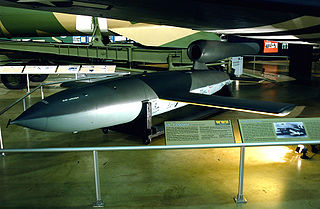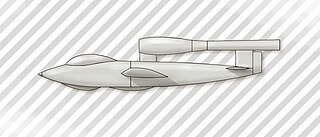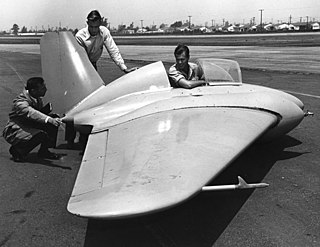
The V-1 flying bomb was an early cruise missile. Its official Reich Aviation Ministry (RLM) designation was Fieseler Fi 103 and its suggestive name was Höllenhund (hellhound). It was also known to the Allies as the buzz bomb or doodlebug and in Germany as Kirschkern or Maikäfer (maybug).

A pulsejet engine is a type of jet engine in which combustion occurs in pulses. A pulsejet engine can be made with few or no moving parts, and is capable of running statically. The best known example may be the Argus As 109-014 used to propel Nazi Germany's V-1 flying bomb.

The Fieseler Fi 103R, code-named Reichenberg, was a German manned version of the V-1 flying bomb. It was developed towards the end of the Second World War and was intended to be used as a human-guided bomb in likely-suicidal attacks against the advancing Allies.
A pulse detonation engine (PDE) is a type of propulsion system that uses detonation waves to combust the fuel and oxidizer mixture.

The Messerschmitt Me 328 was a prototype pulsejet-powered fighter aircraft designed and produced by the German aircraft manufacturer Messerschmitt AG.

Argus Motoren was a German manufacturing firm known for their series of small inverted-V engines and the Argus As 014 pulsejet for the V-1 flying bomb.

A jet pack, rocket belt, rocket pack or flight pack is a device worn on the back which uses jets of fluid to propel the wearer through the air. The concept has been present in science fiction for almost a century and the first working experimental devices were demonstrated in the 1960s.

The Kawanishi Baika was a pulsejet-powered kamikaze aircraft under development for the Imperial Japanese Navy towards the end of World War II. The war ended before any were built.

A valveless pulsejet is the simplest known jet propulsion device. Valveless pulsejets are low in cost, light weight, powerful and easy to operate. They have all the advantages of conventional valved pulsejets, but without the reed valves that need frequent replacement; a valveless pulsejet can operate for its entire useful life with practically zero maintenance. They have been used to power model aircraft, experimental go-karts, and unmanned military aircraft such as cruise missiles and target drones.
The Gluhareff Pressure Jet is a type of jet engine that, like a valveless pulse jet, has no moving parts. It was invented by Eugene Michael Gluhareff, a Russian-American engineer who envisioned it as a power plant for personal helicopters and compact aircraft such as microlights.
The Porsche 005 was a small, single-use turbojet design intended to power a long-range version of the V-1 flying bomb. At the end of World War II, the design of the Porsche 005 turbojet had not been finalised and no parts had been constructed.

The Republic-Ford JB-2, also known as the Thunderbug, KGW and LTV-N-2 Loon, was a United States copy of the German V-1 flying bomb. Developed in 1944, and planned to be used in the United States invasion of Japan, the JB-2 was never used in combat. It was the most successful of the United States Army Air Forces Jet Bomb (JB) projects during World War II. Postwar, the JB-2 played a significant role in the development of more advanced surface-to-surface tactical missile systems such as the MGM-1 Matador and later MGM-13 Mace.
Project SQUID was a United States defense effort post-World War II effort to develop and improve pulsejet and rocket engines, run by the Office of Naval Research.

The Junkers EF 126 was an experimental fighter proposed by the German Miniaturjägerprogramm of 1944–1945, for a cheap and simple fighter powered by a pulsejet engine. No examples were built during the war, but the Soviet Union completed both unpowered and powered prototypes.

The Northrop JB-1A "Bat" or "Thunderbug" was a United States surface-to-surface cruise missile that was a jet-powered flying wing.

Many variations of aircraft engine starting have been used since the Wright brothers made their first powered flight in 1903. The methods used have been designed for weight saving, simplicity of operation and reliability. Early piston engines were started by hand. Geared hand starting, electrical and cartridge-operated systems for larger engines were developed between the First and Second World Wars.

The Blohm & Voss P 213 was a submission to the Miniaturjäger programme of the Luftwaffe Emergency Fighter Program towards the end of the Second World War. The Miniaturjäger was to be powered by a pulse jet but the programme was scrapped in December 1944.

The Messerschmitt P.1079 was a series of different experimental Messerschmitt fighters projected during the Second World War. The last designs were proposed in 1944 towards the end of the Third Reich. Except for the last one, all the aircraft designs were to be powered by pulse jets, the same engines used in the V-1 flying bomb.
Paul Schmidt was a German aerospace engineer and inventor based in Munich, mainly known for his contribution to the development of the pulsejet.

The Kawanishi Maru Ka10 was a World War II Japanese pulsejet engine based on the German Argus As 014 . The Ka10’s only intended application was the Kawanishi Baika.



















